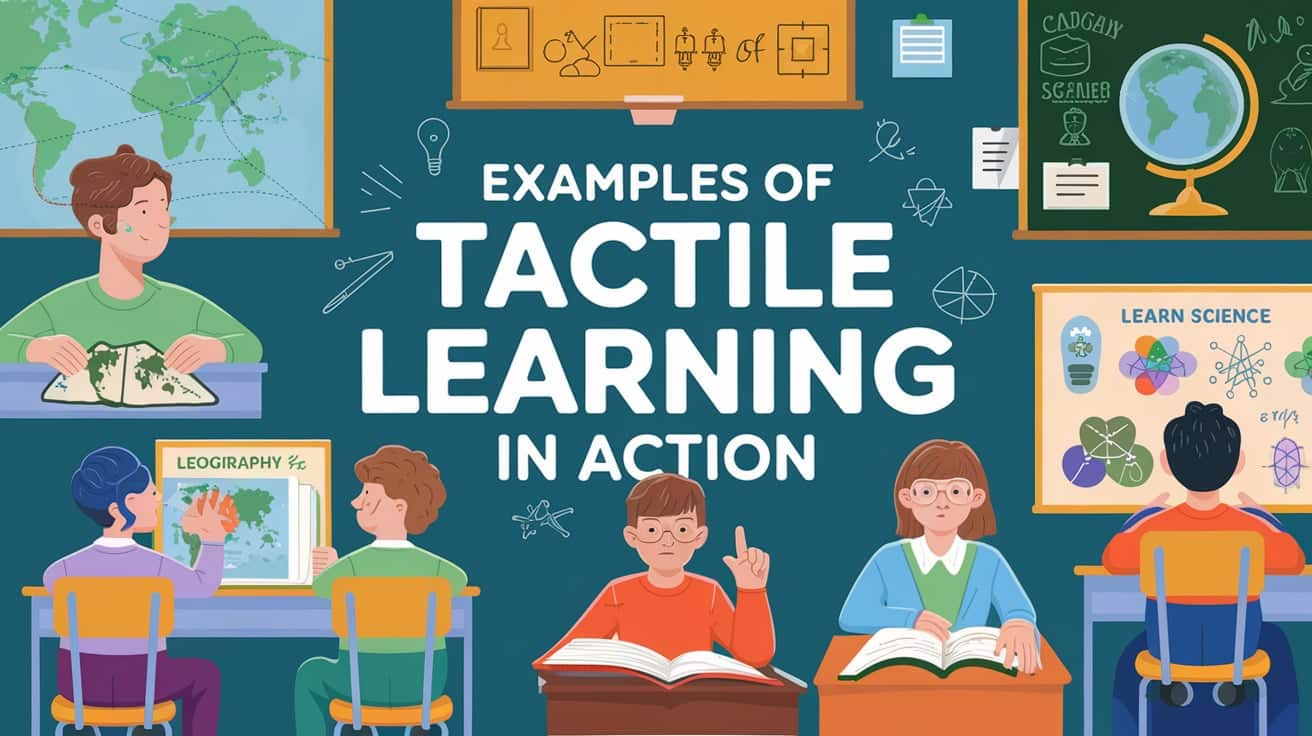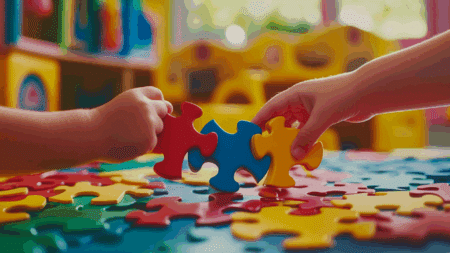Have you ever noticed how some people just need to touch something to really understand it? That’s tactile learning.
Tactile learning is a learning style where people learn best through touch and physical interaction with objects. Examples of tactile learning are all around us, from kids building with blocks to adults practicing a new craft.
This approach is incredibly important in education because it creates deeper neural connections. When we touch and manipulate objects, we engage more senses.
This helps information stick better. Tactile learning breaks down barriers for students who struggle with traditional methods. It makes core concepts concrete.
In this blog, you’ll see practical tactile learning examples that can change how you or your students absorb information.
What is Tactile Learning?
Tactile learning is a way of learning where people understand things best by touching, feeling, and doing physical activities. The word “tactile” simply means relating to the sense of touch.
When someone is a tactile learner, they learn most effectively when they can use their hands and body to explore and interact with the world around them.
Think of a child learning to count. Tactile learners might understand counting much better if they can touch and move actual objects – like counting blocks or beads – rather than just seeing numbers on a page or hearing someone count out loud.
Tactile learning is sometimes also called “kinesthetic learning.”
Many tactile learners need to move their bodies while learning. This might mean walking around while memorizing information, using hand gestures while explaining concepts, or even fidgeting with something in their hands while listening to a lesson.
For many people, especially young children, tactile learning comes naturally.
This natural learning instinct doesn’t disappear as we grow older, though traditional education sometimes doesn’t accommodate it as well as it could.
Great tactile learning involves thoughtfully designed activities that connect physical experiences to the concepts being taught.
For example, they can walk along a physical timeline on the floor to learn historical events, use clay to form the shapes of landforms in geography, or use building blocks to understand structural engineering cores.
Tactile Learning Examples
Tactile learning works best when students can touch, move, and use real objects. These activities keep their hands and minds busy.
1. Braille

Braille uses patterns of raised dots that people feel with their fingertips.
Each pattern represents a different letter, number, or punctuation mark. When someone reads Braille, their fingers move across the page, feeling these tiny bumps. The brain then interprets these touch sensations as letters and words.
For people who are blind, this tactile system opens up a world of reading that would otherwise be unavailable. Learning Braille takes practice as the fingers need to become sensitive enough to distinguish between different dot patterns.
Still, once mastered, it allows independent reading and access to information through touch.
2. Textured Books

Textured books add a whole new dimension to reading by incorporating different materials on their pages.
Imagine a children’s book about animals where the lion has a rough mane you can actually feel, the snake has shiny scales, and the rabbit has soft fur. When children encounter these books, they don’t just see the story, they experience it through touch.
As they run their fingers over a bumpy crocodile skin or a silky flower petal, they connect the visual image with the physical sensation. This multi-sensory approach helps cement concepts in memory and makes reading more engaging.
For young children especially, these tactile elements can help maintain interest and extend attention spans during story time while building connections between words and real-world textures.
3. Sandpaper Letters

Sandpaper letters are a clever teaching tool where alphabet letters are cut out of sandpaper and mounted on smooth cards.
Children learn letters by tracing the rough sandpaper shape with their fingertips, following the same movement pattern used when writing the letter. This approach connects three learning pathways at once: they see the letter shape (visual), feel its texture and form (tactile), and often say the letter sound while tracing (auditory).
The contrast between the rough sandpaper and smooth background helps the brain remember the letter shape more effectively.
This method, popularized in Montessori education, prepares children for writing by training their muscles to form letter shapes before they even pick up a pencil, making the transition to actual writing much smoother.
4. Interactive Globe

An interactive globe goes beyond a standard smooth globe by adding raised surfaces that you can feel with your fingers.
Mountains actually stick up from the surface, and you might feel different textures for deserts, forests, or oceans.
When students explore this type of globe, they can close their eyes and run their hands over the Earth’s features, literally feeling the shape of continents and the location of major mountain ranges.
This hands-on approach helps create a mental map that’s much more detailed than what they would get from just looking at a flat map or smooth globe.
For many learners, physically touching the bumps of the Himalayas or feeling the outline of Africa creates stronger memories and a better understanding of global geography than visual learning alone.
5. 3D Maps

Unlike flat paper maps, these raised-relief maps show the actual shape of the land – mountains rise, valleys sink, and rivers cut through the terrain.
When students use these maps, they can run their fingers along a mountain range to feel how it extends across a region or trace the path of a river from its source in the mountains down to the ocean.
This tactile experience helps them understand concepts like elevation, watershed, and how geography influences human settlement patterns.
For someone who learns best through touch, feeling the dramatic rise of the Andes Mountains or the flat expanse of the Great Plains creates a much more memorable and accurate understanding than simply seeing these features on a flat map.
6. Tactile Number Lines

A tactile number line is a math learning tool with raised or textured numbers and markings that students can feel with their fingers.
Unlike a drawn number line, the numbers and divisions are physically elevated from the surface. As learners move their fingers from left to right, they can feel each number’s position and the spaces between them.
This physical interaction helps them understand number sequence, intervals, and relationships between numbers. When adding or subtracting, students can literally count the jumps between numbers by feeling each position.
This concrete experience is especially helpful for young children who are still developing abstract mathematical thinking.
The physical movement along the line also reinforces the concept that numbers keep increasing as you move right and decreasing as you move left, building a foundation for number sense that will support more advanced math concepts later.
7. Thermoplastic Models

Thermoplastic models are hands-on teaching tools made from special plastics that can be shaped and manipulated to represent complex scientific structures.
In a biology class, students might hold a 3D model of a cell, feeling the different shapes of organelles like the mitochondria or nucleus. In chemistry, they might snap together atom models to build molecules, physically experiencing how elements combine.
Unlike flat diagrams in textbooks, these models allow students to turn, twist, and examine structures from all angles. This three-dimensional exploration helps learners understand spatial relationships that can be difficult to grasp from images alone.
For example, handling a DNA model helps students truly comprehend the double helix structure in a way that pictures cannot convey. These tactile experiences make abstract scientific concepts more concrete and memorable.
8. Tactile Games

Tactile games specifically designed for learning through touch use raised surfaces, different textures, and objects that can be manipulated by hand.
For example, a child might play a matching game where they need to find pairs of cards with the same raised pattern without looking, using only their sense of touch. Board games with pieces that have distinctive shapes help players recognize and remember game elements through feel.
These games are particularly valuable for visually impaired learners, but they benefit all tactile learners by engaging their strongest learning channel.
As players handle game pieces, cards with raised symbols, or textured game boards, they develop discrimination skills, pattern recognition, and memory through touch.
9. Rock Samples

Rock samples provide an ideal tactile learning experience for geology education because rocks are naturally meant to be handled and examined with multiple senses.
When students pick up actual rock specimens, they immediately notice things that pictures can’t convey—the surprising weight of a dense igneous rock, the cool smoothness of polished marble, or the way sedimentary rocks might crumble slightly at the edges.
By rubbing their fingers across different rock surfaces, learners can feel the coarse grains in granite, the slippery smoothness of soapstone, or the sharp crystalline structure of quartz.
This hands-on examination helps students understand rock properties and classification in a way that reading descriptions never could.
The physical memory of holding and manipulating different rock types creates learning connections that help students identify and categorize rocks they see in the future.
10. Rubber Stamps for Spelling

Rubber stamps with raised letters turn spelling practice into a multi-sensory experience that engages tactile learners.
Instead of just writing words with a pencil, children press these stamps onto paper, feeling the shape of each letter as they create words.
The process involves selecting the correct letters, arranging them in the proper sequence, and applying pressure to transfer the image to paper. Each of these steps provides tactile feedback that reinforces letter recognition and word formation.
The physical act of stamping also makes spelling more engaging and fun, encouraging children to practice longer. Additionally, the stamped result creates a clear, consistent letter shape that helps with visual recognition, benefiting children who might struggle with handwriting.
This combination of touching the letter forms and seeing the perfectly formed result helps cement spelling patterns in memory through multiple sensory channels.
11. Sensory Bottles

Sensory bottles are transparent containers filled with a variety of materials suspended in liquid that create different visual and tactile experiences when handled.
A bottle might contain colored water with glitter, small beads, buttons, or tiny toys that move when the bottle is tilted or shaken.
As children manipulate these bottles, they observe how objects move at different speeds depending on the liquid’s thickness, how some items float while others sink, and how the contents respond to different movements.
This introduces concepts like density, viscosity, and gravity in an accessible way. The bottles also serve as calming tools, as the repetitive motion of turning them and watching the contents shift can help children regulate their emotions.
12. Fabric Matching Games

Fabric matching games use pairs of fabric swatches with distinct textures for children to identify and match through touch.
Players might feel samples of silk, burlap, corduroy, velvet, denim, and other materials, learning to recognize each unique texture with their fingertips.
This activity develops fine discrimination skills as children learn to notice subtle differences between similar fabrics. Beyond simply matching identical textures, these games can expand to categorizing fabrics by properties, sequencing them from roughest to smoothest, or blindfolded identification challenges.
The game format engages children in learning about material properties while building their vocabulary, as they learn words like “coarse,” “slippery,” or “fuzzy” to describe their feelings.
This tactile experience also provides foundation knowledge for science concepts like material properties and classifications while developing the sensory awareness that supports many daily life skills.
13. Raised Graphs and Charts

Raised graphs and charts transform flat visual data presentations into three-dimensional representations that can be explored through touch.
These specialized learning tools feature elevated lines, bars, or sections that correspond to data points. For example, a bar graph showing monthly rainfall might have bars that physically rise to different heights that can be felt with the fingers.
This adaptation makes data accessible to visually impaired learners, but it benefits all tactile learners by adding a physical dimension to abstract numerical concepts.
This tactile interaction helps learners understand trends, comparisons, and proportional relationships in a concrete way, building bridges to more abstract mathematical thinking about data representation.
14. Magnetic Letters and Numbers

Magnetic letters and numbers are learning tools that stick to metal surfaces, allowing students to manipulate them while learning physically.
Children can move these colorful pieces around on refrigerators, magnetic boards, or special trays, creating words, sentences, or math equations. The physical act of picking up letters, feeling their shapes, and arranging them into words helps reinforce spelling patterns and letter recognition.
For math concepts, moving magnetic numbers around to create equations gives children a concrete way to understand abstract operations.
The ability to easily rearrange the pieces encourages experimentation and correction, making learning more interactive and less intimidating.
Unlike writing on paper, which is permanent, the movable nature of magnetic pieces allows for practice without the fear of making mistakes.
15. Tactile Art Supplies

Materials like finger paint, clay, textured papers, fabric scraps, and natural items such as leaves or seeds provide diverse tactile feedback as children create.
When children squish clay between their fingers, they learn about malleability and how materials can transform through pressure. Collage-making with various textured papers helps them distinguish between rough, smooth, bumpy, or soft surfaces while making artistic choices.
These materials naturally invite exploration—children might press, roll, fold, tear, or squeeze them, discovering properties and possibilities through physical interaction.
Beyond just sensory engagement, these tactile experiences develop fine motor skills, hand strength, and coordination that support later writing abilities.
How Tactile Learning Differs from Other Learning Styles
Tactile learning is hands-on and action-based. Students learn best by touching, moving, and doing.
It’s different from visual and auditory learning, which rely on seeing or hearing. Tactile learners need real activities to fully understand and remember ideas.
| Learning Style | How They Learn Best | Preferred Activities | Typical Challenges | Ideal Study Environment |
|---|---|---|---|---|
| Tactile Learning | Through touch, movement, and physical interaction | Building models, experiments, role-play, using manipulatives | Sitting still for long periods, traditional lecture formats | Workshop spaces, labs, and areas that allow movement and hands-on work |
| Visual Learning | Through seeing images, diagrams, and demonstrations | Watching videos, examining charts/graphs, color-coding notes | Purely verbal instructions, lack of visual aids | Organized spaces with visual aids, minimal visual distractions |
| Auditory Learning | Through listening and verbal discussions | Lectures, discussions, reading aloud, verbal repetition | Noisy environments, having to read silently for long periods | Quiet spaces for listening, areas that allow for verbal processing |
| Reading/Writing Learning | Through text-based information | Reading textbooks, taking detailed notes, writing summaries | Learning without written materials, hands-on activities without instruction | Quiet library settings, organized desk spaces with writing materials |
Understanding these learning styles helps teachers reach every student better. While each style has its strengths, knowing how tactile learners differ reminds us to mix up our teaching methods.
A balanced classroom with visual tools, spoken lessons, and hands-on tasks gives all learners a fair chance to succeed.
Conclusion
Tactile learning offers a powerful way to connect with information through our sense of touch. Engaging with physical materials strengthens memory pathways in our brains and deepens our understanding of concepts across all subjects.
Maybe you’re a teacher looking for new ways to reach students, a parent supporting a child who learns best through touch, or an adult seeking to enhance your learning.
Tactile approaches like these can make a remarkable difference.
Try adding one tactile learning activity to your routine this week. You can pick an idea from our list or create your own!




